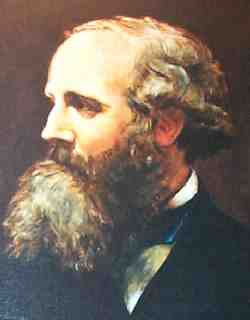Maxwell's Equations

"The most significant event of the 19th century will be judged as Maxwell's discovery of the laws of electrodynamics." - Richard Feynman.
A shy, somewhat dull child who earned the nickname "Dafty" while at Edinburgh Academy, James Clerk Maxwell -- born on this day in 1831 in Edinburgh -- had an intense curiosity about the mechanics of everyday objects, and later, much ahead of his schoolmates, developed an appreciation for the power of mathematical models. At 14 he wrote a paper on a method of drawing elipses using pins and thread which was published by the Edinburgh Royal Society (a not entirely new idea -- the mathematical basis for it was proposed by Descartes -- but it was a remarkable adaptation for a 14 year-old).
He read Newton at the University of Edinburgh and in 1850 went to Cambridge, where he met the cream of Britain's young scientists; they found him eccentric and a bit difficult to follow as he jumped excitedly from topic to topic, but nonetheless they seemed to recognize his intellectual gifts. After graduation in 1854, he went to teach at Marischal College in Aberdeen, where he studied the rings of Saturn and described them as being composed of numerous small solid particles (that being the best mathematical explanation for their stability), a description which was verified by NASA's Voyager probe in 1980. He married the daughter of the principal at Marischal in 1859, but that did not save his job as a junior professor when Marischal merged with King's College Aberdeen the following year. He managed to obtain the chair of natural philosophy at King's College London shortly thereafter, where he did his most important work.
Before Maxwell's work on electromagnetism, although predecessors such as Michael Faraday did develop a sophisticated understanding of the circumstances in which electrical induction could exist and how to produce it, they did not have a mature or very clear picture of the shape of electricity and its movements. Maxwell replaced the old "machine-like" models of electricity (put it in here and it comes out here) with a mathematical model which would predict electrical phenomena. Before a mystified Royal Society meeting in 1864, Maxwell read his "Dynamical Theory of the Electromagnetic Field," unveiling the equations which comprise the basic laws of electromagnetism, and showing that an electric charge sends waves through space at some frequency.
From his work, Maxwell could predict the existence of the whole invisible spectrum of electromagnetic frequencies, including radio waves, microwaves, infrared and ultraviolet waves, X-rays and gamma rays, as well as pinpointing the speed of electricity at about 300,000 kilometers per second - so close to the speed of light as to suggest that light itself was an electromagnetic disturbance. Maxwell's equations, which finally appeared in their most developed form in Electricity and Magnetism (1874), were puzzling to scientists of the time; but after Maxwell's death, Heinrich Hertz (at the urging of Heinrich von Helmholtz) confirmed Maxwell's theory of electromagnetism in a series of experiments which measured electromagnetic "waves" and showed how electricity behaved like light.
The verification of Maxwell's equations, then, became an important first step in the development of 20th century atomic physics; on the practical side of things, Maxwell's equations are used today in the design of everything from integrated circuits to cellular phones to predict and reduce levels of electromagnetic interference. Applying a similar theoretical basis to the study of gases, Maxwell also shares credit for the "Maxwell-Boltzmann" kinetic theory of gases: working independently of Ludwig Boltzmann, Maxwell showed that temperatures and heat were manifestations of molecular movement, and Maxwell attempted to describe such movement mathematically.
At the time of his death on November 5, 1879 of abdominal cancer (at age 49, the same age his mother died of the same disease), most scientists were pretty sure Maxwell was onto something, but only time would show the true extent of his brilliance and influence.
Labels: Physicists





1 Comments:
Note TYPO, at the beginning of last paragraph. Otherwise, the blog is well-written and very informative. Thanks -
(Typo : "At the time of his death on died of abdominal cancer on November 5, 1879 at age 49"...)
Post a Comment
Subscribe to Post Comments [Atom]
<< Home